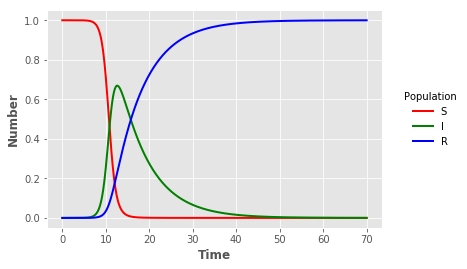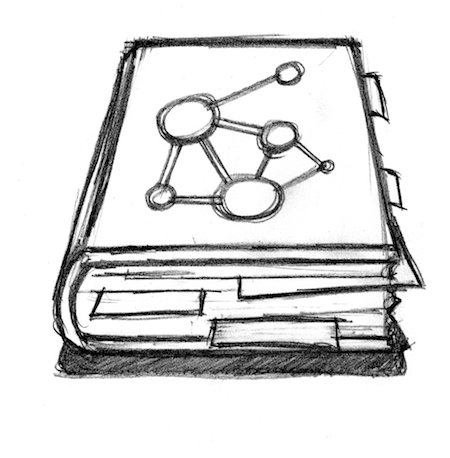%%writefile Program_2_1.f
C
C This is the FORTRAN version of program 2.1 from page 19 of
C "Modeling Infectious Disease in humans and animals"
C by Keeling & Rohani.
C
C It is the simple SIR epidemic without births or deaths.
C
C This code is written to be simple, transparent and readily compiled.
C Far more elegant and efficient code can be written.
C
C This code can be compiled using the intel fortran compiler:
C ifort -Vaxlib -o Program_2_1 Program_2_1.f
C
C Main program starts here.
program main
REAL beta
REAL gamma
REAL S,I,R
REAL S0
REAL I0
REAL MaxTime
REAL EVERY, step, t
INTEGER GivesName
CHARACTER*2000 str, FileName
COMMON /parameters/ beta, gamma
COMMON /variables/ S, I, R
GivesName=iargc()
if (GivesName.eq.0) then
beta=1.4247
gamma=0.14286
S0=1 - 1.0d-6
I0=1.0d-6
MaxTime=70
else
c
c READ IN ALL THE VARIABLES
c
call getarg(1,FileName)
open(1,file=FileName,STATUS='OLD',ACCESS='SEQUENTIAL')
read(1,*) str
read(1,*) beta
read(1,*) str
read(1,*) gamma
read(1,*) str
read(1,*) S0
read(1,*) str
read(1,*) I0
read(1,*) str
read(1,*) MaxTime
close(1)
endif
C
C Check all variables are OK & set up intitial conditions */
C
if ( S0.le.0) then
write(*,*) "ERROR: Initial level of susceptibles (",S0,") is
. less than or equal to zero."
STOP
endif
if ( I0.le.0) then
write(*,*) "ERROR: Initial level of infecteds (",I0,") is
. less than or equal to zero."
STOP
endif
if ( beta.le.0) then
write(*,*) "ERROR: Transmission rate beta (",beta,") is
. less than or equal to zero."
STOP
endif
if ( gamma.le.0) then
write(*,*) "ERROR: Recovery rate gamma (",gamma,") is
. less than or equal to zero."
STOP
endif
if ( MaxTime.le.0) then
write(*,*) "ERROR: Maximum run time (",MaxTime,") is
. less than or equal to zero."
STOP
endif
if (S0+I0.ge.1) then
write(*,*) "WARNING: Initial level of susceptibles+infecteds
. (",S0,"+",I0,"=",S0+I0,") is greater than one."
endif
if (beta.lt.gamma) then
write(*,*) "WARNING: Basic reproductive ratio (R_0=",
. beta/gamma,") is less than one."
endif
S=S0
I=I0
R=1-S0-I0
C
C Find a suitable time-scale for outputs
C
step=0.01/((beta+gamma)*S0)
Every=1.0/((beta+gamma)*S0)
if (Every.gt.1) then
Every=10.0**INT(log10(Every))
else
Every=10.0**INT(log10(Every)-1)
endif
DO WHILE (MaxTime/Every.gt.10000)
Every=Every*10.0
ENDDO
open(1,recl=3000,file='Program_2_1_f.out',ACCESS='SEQUENTIAL')
C for F77 use
C open(1,file='Output_Risk',ACCESS='SEQUENTIAL')
C
C
C The main iteration routine
C
t=0
write(1,*) t,S,I,R
DO WHILE (t.lt.MaxTime)
CALL Runge_Kutta(step)
t=t+step
C If time has moved on sufficiently, output the current data
if( INT(t/Every).gt.INT((t-step)/Every) ) then
write(1,*) t,S,I,R
endif
ENDDO
END
SUBROUTINE Runge_Kutta(step)
REAL InitialPop(3), tmpPop(3)
REAL dPop1(3), dPop2(3), dPop3(3), dPop4(3)
REAL S,I,R, step
COMMON /variables/ S, I, R
C
C Integrates the equations one step, using Runge-Kutta 4
C Note: we work with arrays rather than variables to make the
C coding easier
C
InitialPop(1)=S
InitialPop(2)=I
InitialPop(3)=R
CALL Diff(InitialPop,dPop1)
do k=1,3
tmpPop(k)=InitialPop(k)+step*dPop1(k)/2.0
ENDDO
CALL Diff(tmpPop,dPop2)
do k=1,3
tmpPop(k)=InitialPop(k)+step*dPop2(k)/2.0
ENDDO
CALL Diff(tmpPop,dPop3)
do k=1,3
tmpPop(k)=InitialPop(k)+step*dPop3(k)
ENDDO
CALL Diff(tmpPop,dPop4)
do k=1,3
tmpPop(k)=InitialPop(k)+step*(dPop1(k)/6 + dPop2(k)/3 +
. dPop3(k)/3 + dPop4(k)/6)
ENDDO
S=tmpPop(1)
I=tmpPop(2)
R=tmpPop(3)
RETURN
END
C The Main Differential Equations.
SUBROUTINE Diff(Pop, dPop)
REAL Pop(3), dPop(3)
REAL beta
REAL gamma
COMMON /parameters/ beta, gamma
C Set up temporary variables to make the equations look neater
REAL tmpS, tmpI, tmpR
tmpS=Pop(1)
tmpI=Pop(2)
tmpR=Pop(3)
C
C The differential equations
C
C dS/dt =
dPop(1) = - beta*tmpS*tmpI
C dI/dt =
dPop(2) = beta*tmpS*tmpI - gamma*tmpI
C dR/dt =
dPop(3) = gamma*tmpI
RETURN
END

